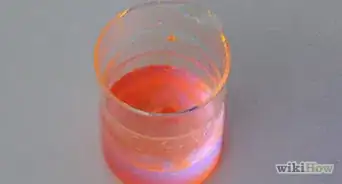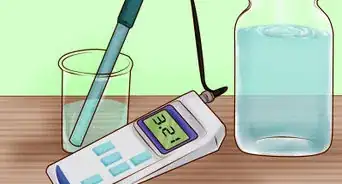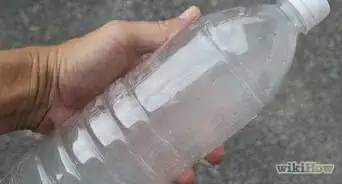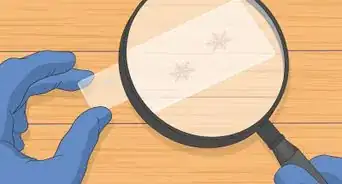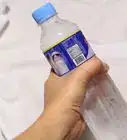This article was co-authored by Bess Ruff, MA. Bess Ruff is a Geography PhD student at Florida State University. She received her MA in Environmental Science and Management from the University of California, Santa Barbara in 2016. She has conducted survey work for marine spatial planning projects in the Caribbean and provided research support as a graduate fellow for the Sustainable Fisheries Group.
This article has been viewed 103,516 times.
Salts are neutral compounds that consist of some set ratio of positive ions (cations) to negative ions (anions). Salts are formed when an acid and a base come in contact and neutralize each other. Common salts are sodium chloride (table salt) and magnesium sulfate (Epsom salt). While one salt is different from another, they share similar properties. One of these properties is that a salt can be dissolved into water.
Steps
Choosing Your Ingredients
-
1Choose a salt. There are many different salts available, and they all have different properties.The amount of Epsom salt (MgSO4) that you can dissolve into a given amount of water at a given temperature will differ from the amount of table salt (NaCl) that you can dissolve into the same water.[1]
- If you are trying to understand the dissolution process in general, you should stick with using table salt since the particles are smaller and will therefore dissolve easier.
- If you need to study the properties of a specific salt, use that salt.
-
2Choose your water. The kind of water you use matters. For example, tap water has more contaminants than distilled water. Deionized water can often be even more pure than distilled water. The purer the water (i.e. the less contaminants it contains) the more salt you will be able to dissolve into it.[2]
- This is because there are fewer water molecules interacting with other substances in the water, and therefore, more water molecules free to dissolve the salt.
Advertisement -
3Decide how much of each you will use. You will need to decide how much (how many grams) salt you intend to put into your water. You will also need to know how much water you are using. If you use too much salt (or too little water) then you will not be able to dissolve all of it.[3]
- You can add salt slowly to see approximately how much can be dissolved in a given amount of water (at a given temperature).
- You can dissolve more salt by adding more water or heating it up.
Mixing Your Solution
-
1Pour your water into a container. If you are measuring out a specific amount of water, you can use a graduated cylinder or a beaker. If you aren’t as worried about exact measurements, any container will do. Keep in mind that the temperature of the container can affect the temperature of your water. This isn’t a big deal for most experiments, but if you are doing highly controlled experiments, it is worth considering.[4]
- Make sure to label your container, especially if you are working in a lab with other people.
-
2Weigh out your salt. Put weigh paper or a weigh boat on your scale and zero the scale. Add salt a little at a time until you reach the desired amount of salt. Record the exact amount of salt that you used.[5]
-
3Pour the salt into the water. If the salt does not immediately dissolve, try mixing it with a spoon or spatula. You need water molecules to come in contact with your salt to dissolve it, and stirring things up helps that happen more quickly. You can also heat the mixture to help the salt dissolve.[6]
Accounting for Other Variables
-
1Account for the temperature of the water. When you are analyzing how much salt you can or cannot dissolve into a given volume of water, you should consider the temperature. Warmer water will dissolve more salt than cooler water, regardless of the type of salt you are using. If you are doing a formal experiment, you should record the exact temperature of your water.[7]
- There is more space between the water molecules if it is at a higher temperature, which is why it dissolves salt better. Cold water has less space between the water molecules, so less salt fits in between them.
-
2Account for other solutes in the water. The more solutes (things dissolved into the water) present, the less water molecules are available to interact with your salt. There can also be interaction between the solutes and the salt, depending on what solutes are present. If you are not studying the interaction of a specific solute with your salt, it is best to use distilled or deionized water to minimize the amount of contamination.[8]
-
3Account for impurities in your salt. Your water isn’t the only non-perfect substance you’ll be working with. Your salt is bound to have some level of impurity. If you purchased your salt, it is likely food or commercial grade and the impurities will be negligible for most experiments. If you made your own salt or mined your own salt, then impurities might be higher.[9]
Community Q&A
-
QuestionShould I use hot water for this experiment?
 Community AnswerHot water will make the salt dissolve more easily, but you don't have to use hot water if you don't want to.
Community AnswerHot water will make the salt dissolve more easily, but you don't have to use hot water if you don't want to. -
QuestionHow do I find the solubility of the salt in a given amount of water?
 TomPNTop AnswererMeasure out a fixed amount of water (e.g., 1 liter). Add salt one gram at a time, stirring until it completely dissolves. Repeat until no more will dissolve. With table salt and pure water, you should get around 350-360 grams of salt per liter of water to dissolve.
TomPNTop AnswererMeasure out a fixed amount of water (e.g., 1 liter). Add salt one gram at a time, stirring until it completely dissolves. Repeat until no more will dissolve. With table salt and pure water, you should get around 350-360 grams of salt per liter of water to dissolve. -
QuestionHow do I know when the salt is dissolved?
 AkshithaaCommunity AnswerThe water will be clear, without any residue in the bottom of the glass.
AkshithaaCommunity AnswerThe water will be clear, without any residue in the bottom of the glass.
Warnings
- If you are heating a solution, be careful not to burn yourself.⧼thumbs_response⧽
- Salts can react with your skin and other moist parts of your body. This can sting and burn. It is best not to come in direct contact with your salt.⧼thumbs_response⧽
Things You’ll Need
- Salt
- Water
- Container
- Scale
- Weigh Boat or Paper
- Spoon or Spatula
- Heat Source
- Gloves
- Goggles
References
- ↑ https://www.msnucleus.org/membership/html/k-6/wc/oceans/1/wcoc1_2a.html
- ↑ https://www.msnucleus.org/membership/html/k-6/wc/oceans/1/wcoc1_2a.html
- ↑ https://www.acs.org/education/resources/k-8/inquiryinaction/fifth-grade/chapter-1-investigating-matter-at-the-particle-level/lesson-1-3--dissolving-and-back-again.html
- ↑ http://www.middleschoolchemistry.com/lessonplans/chapter5/lesson3
- ↑ https://www.msnucleus.org/membership/html/k-6/wc/oceans/1/wcoc1_2a.html
- ↑ http://www.middleschoolchemistry.com/lessonplans/chapter5/lesson3
- ↑ http://www.infoplease.com/cig/science-fair-projects/salt-sugar-dissolves-faster-different-liquids.html
- ↑ http://www.middleschoolchemistry.com/lessonplans/chapter5/lesson3
- ↑ http://www.middleschoolchemistry.com/lessonplans/chapter5/lesson3
About This Article
The amount of salt you can dissolve in water depends on a few variables like temperature and purity. To dissolve salt into water, just stir it in with a spoon or spatula until you can't see the salt anymore. The higher the temperature of the water, the more salt you'll be able to dissolve, so if you want to dissolve more salt, heat up your water. You can also dissolve more salt in distilled water, since there are less contaminants. For more tips from our Science co-author, including how to choose a type of salt to dissolve, read on!

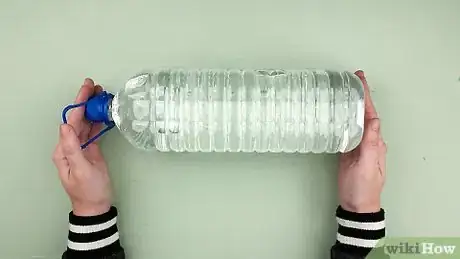
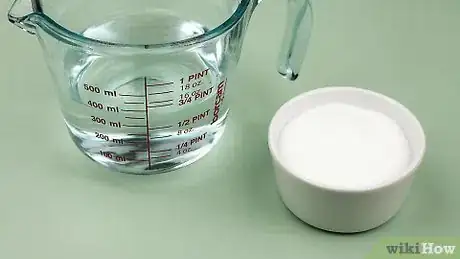
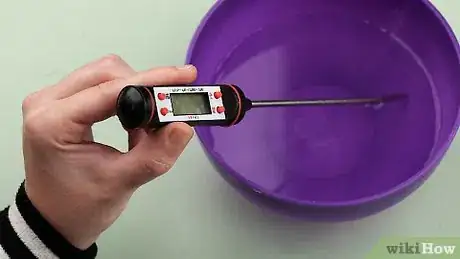
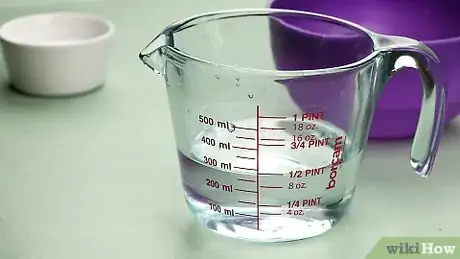
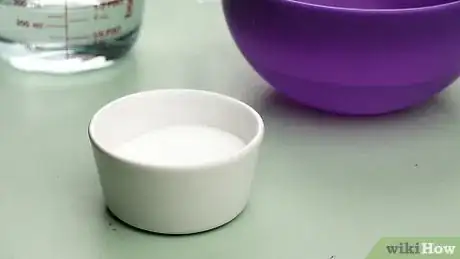
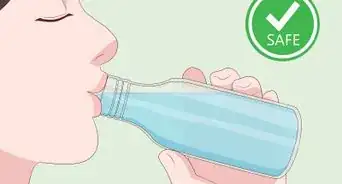
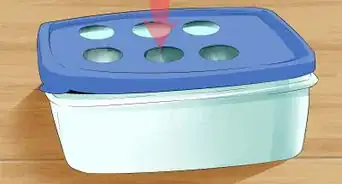

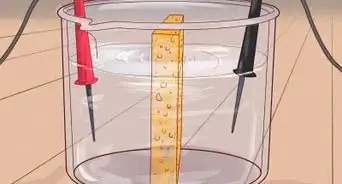

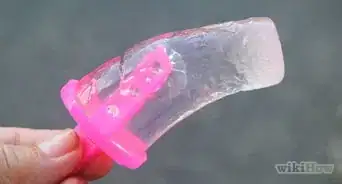

-Step-15.webp)
